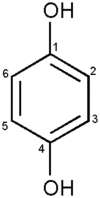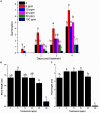Hydroquinone; A Novel Bioactive Compound from Plant-Derived Smoke Can Cue Seed Germination of Lettuce
- PMID: 28553632
- PMCID: PMC5427145
- DOI: 10.3389/fchem.2017.00030
Hydroquinone; A Novel Bioactive Compound from Plant-Derived Smoke Can Cue Seed Germination of Lettuce
Abstract
Plant-derived smoke has been known to play an important role in distribution and growth of vegetation. Using a proficiently designed furnace, we extracted smoke from the leaves of four plant viz. Helianthus annuus,Aloe vera,Ginkgo biloba, and Cymbopogon jwarancusa. Smoke dilutions obtained from these plants were obtained in different concentrations to identify potential lettuce growth promoting smoke solution. Results revealed that smoke obtained from G. biloba significantly enhanced the lettuce seed germination. This solution was then partitioned into ethyl acetate, dichloromethane, n-hexane, chloroform and ether fractions. Ethyl acetate fraction was found to be potent to enhance seed germination. This fraction was subjected to column chromatography and spectroscopic techniques to obtain compound 1. This compound was identified as hydroquinone using 1D and 2D NMR techniques. At low concentrations (5, 10, and 20 ppm), compound 1 enhanced the lettuce seed germination; however, higher concentrations inhibited its growth as compared to control.
Keywords: Ginkgo biloba; column chromatography; hydroquinone; lettuce; plant-derived smoke; secondary metabolites; seed germination.
Figures






Similar articles
-
Seed germination-influencing bioactive secondary metabolites secreted by the endophyte Cladosporium cladosporioides LWL5.Molecules. 2013 Dec 13;18(12):15519-30. doi: 10.3390/molecules181215519. Molecules. 2013. PMID: 24352011 Free PMC article.
-
Butenolides from plant-derived smoke: natural plant-growth regulators with antagonistic actions on seed germination.J Nat Prod. 2010 Feb 26;73(2):267-9. doi: 10.1021/np900630w. J Nat Prod. 2010. PMID: 20078110
-
Formation of a seed germination promoter from carbohydrates and amino acids.J Agric Food Chem. 2005 Jul 27;53(15):5936-42. doi: 10.1021/jf050710u. J Agric Food Chem. 2005. PMID: 16028977
-
Plant-Derived Smoke Affects Biochemical Mechanism on Plant Growth and Seed Germination.Int J Mol Sci. 2020 Oct 20;21(20):7760. doi: 10.3390/ijms21207760. Int J Mol Sci. 2020. PMID: 33092218 Free PMC article. Review.
-
Regulation of seed germination and seedling growth by chemical signals from burning vegetation.Annu Rev Plant Biol. 2012;63:107-30. doi: 10.1146/annurev-arplant-042811-105545. Epub 2012 Feb 9. Annu Rev Plant Biol. 2012. PMID: 22404467 Review.
Cited by
-
Plant-Derived Smoke and Karrikin 1 in Seed Priming and Seed Biotechnology.Plants (Basel). 2023 Jun 19;12(12):2378. doi: 10.3390/plants12122378. Plants (Basel). 2023. PMID: 37376003 Free PMC article. Review.
-
Rice straw-derived smoke water promotes rice root growth under phosphorus deficiency by modulating oxidative stress and photosynthetic gene expression.Sci Rep. 2023 Sep 8;13(1):14802. doi: 10.1038/s41598-023-41987-5. Sci Rep. 2023. PMID: 37684292 Free PMC article.
-
Karrikin signalling: impacts on plant development and abiotic stress tolerance.J Exp Bot. 2024 Feb 12;75(4):1174-1186. doi: 10.1093/jxb/erad476. J Exp Bot. 2024. PMID: 38001035 Free PMC article.
-
An Interplay of Light and Smoke Compounds in Photoblastic Seeds.Plants (Basel). 2022 Jul 4;11(13):1773. doi: 10.3390/plants11131773. Plants (Basel). 2022. PMID: 35807725 Free PMC article. Review.
-
A New Method for Discovering Plant Biostimulants.Plants (Basel). 2023 Dec 23;13(1):56. doi: 10.3390/plants13010056. Plants (Basel). 2023. PMID: 38202363 Free PMC article.
References
-
- Adkins S. W., Peters N. C. B. (2001). Smoke derived from burnt vegetation stimulates germination of arable weeds. Seed Sci. Res. 11, 213–222. 10.1079/SSR200177 - DOI
-
- Adriansz T. D., Rummey J. M., Bennett I. J. (2000). Solid phase extraction and subsequent identification by gas-chromatography-mass spectrometry of a germination cue present in smoky water. 33, 2793–2804. 10.1080/00032710008543223 - DOI
-
- Baker K. S., Steadman K. J., Plummer J. A., Merritt D. J., Dixon K. W. (2005). Dormancy release in Australian fire ephemeral seeds during burial increases germination response to smoke water or heat. Seed Sci. Res. 15, 339–348. 10.1079/SSR2005222 - DOI
-
- Barkosky R. R., Butler J. L., Einhellig F. A. (1999). Mechanisms of hydroquinone-induced growth reduction in leafy spurge. J. Chem. Ecol. 25, 1611–1621. 10.1023/A:1020892917434 - DOI
LinkOut - more resources
Full Text Sources
Other Literature Sources

